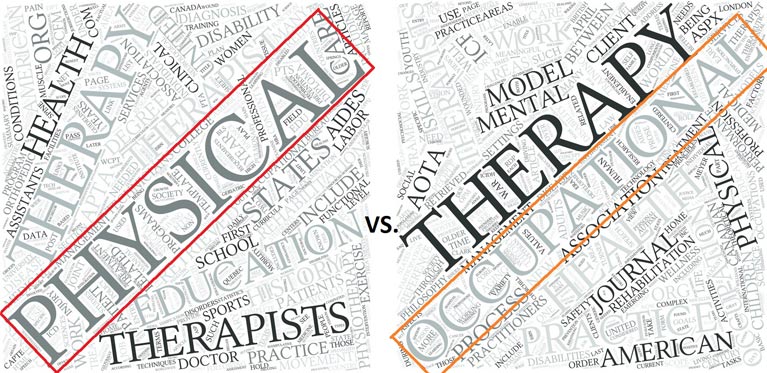Many people are often confused about the differences between physical therapy and occupational therapy.
One reason is their similarity in goals to help patients in rehabilitating and returning to their daily lives. Additionally, both are hands-on professions that work with people who have disabilities, injuries or impairments.
Despite the similarities, there are significant differences between PT and OT. Here, we explore the differences between the two, where they overlap and what that means for you.
What does Occupational Therapy encompass?
Occupational Therapy (OT) origins go back to c. 100 BCE, where treatment of mentally ill patients incorporated massages, baths, exercise, and music.
Its recognition as a health profession became more established in the 1920s in association with WWI and the excess amount of war-related injuries. The philosophy initially focused around providing basic human needs – or, activities of daily living – as a therapeutic activity. Eventually, OT evolved into a much larger framework.
It still involves activities of daily living which can be feeding, dressing, transferring/mobility, personal care in all age ranges and disabilities. It also expands to the instrumental activities of daily living which include caring for your pet, meal preparation, medication management, safety and emergency maintenance.
There are many aspects related to the activities of daily living:
- Rest and sleep
- Education
- Work
- Leisure
- Social participation
OT also includes promoting health in addition to mental health, such as with working with an adult with Autism on social skills or coaching a cancer patient with stress reduction methods and fatigue management skills.
So, what does Physical Therapy encompass?
Physical Therapy (PT) is sometimes referred to as Physiotherapy. Like OT, it developed further as a profession due to the excessive number of war injuries in WWI. Physical Therapy also has roots c. 460 BC with references by Hippocrates to massages, manual therapy and hydrotherapy as treatments.
Unlike OT, PT became instrumental in treating children with Polio in the early 1900s and was originally only a hospital based practice that has since expanded to clinics, sports teams, and schools.
Physical Therapists are trained to analyze, assess, diagnose and treat impairments, limitations of function or disabilities. They often choose specialty areas to focus their practice as with Geriatric, Orthopedic, Pediatric, Sports, and Women's Health.
An example would be a physical therapist visiting your home after hip surgery to help with walking exercises and safety. Conversely, you may see a PT in a school system working with a child with developmental delays helping them learn to stand by strengthening their lower extremities in therapeutic play.
PT's are most commonly correlated with treating orthopedic injuries from athletes and surgeries, but the profession spans from post-pregnancy issues to brain trauma.
What are the differences between the two?
The general thought process is that Physical Therapy treats the gross-motor movements while Occupational Therapy treats the fine-motor. As you can see from the discussion above, it is much more complex.
For example, an Occupational Therapist in a school setting may work on handwriting or feeding as well as sensory processing issues, while a Physical Therapist would address movement, strength, balance and sensory issues.
If you have any questions or would like further information, please contact your local Set Physical Therapist.





